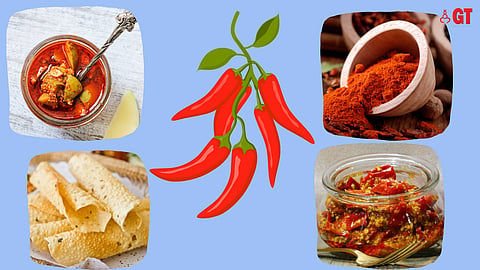

How tasteless would life be if not for a bit of spice? Goa’s famous spicy curry is world-famous for its positive attributes which make one forget how much one has consumed. The secret of its flavour and ability to whet appetites is the chillies that are used to prepare the curry masala.
Farmers from Khola and other parts of Goa work hard to cultivate these red and green chillies.
Khola Chilli powder can be stored for a long duration as it does not attract pests. Chilli powder added to food recipes lends an attractive red colour to the dish.
Khola chilli is a famous variety of chilli grown on the hill slopes of Canacona, located in the district of South Goa. Named after the village of Khola where it is exclusively grown, the chilli is known for its distinctive taste and colour.
Khola chillies are attractive brilliant red and long. It is moderately pungent. The skin of the chillies is thick, hence there is a reduced chance of breakage, giving the chilli a longer shelf-life. Its length is approximately 5.6 to 7.4 cm, and its diameter is 1.2 to 1.4 cm.
The villagers of Khola have been actively involved in the cultivation and conservation of Khola chillies for generations. The traditional method of using green manure also helps with soil erosion in heavy rainfall, while mulching as organic fertiliser is still used as a unique method in Khola chilli cultivation, making it completely organic produce.
Nearly every villager of Khola is involved in the cultivation of the chilli on the slopes of the mountains and the open plains.
Nursery preparations begin in May, using seeds to propagate seedlings. The land is dug well and raised seed beds of 3 m length, 1 m breadth and 15 cm height are prepared. About 5 kg of cow dung manure is mixed well with the soil in each bed.
Around 45 to 60 gm seed is sown in shallow furrows, 7 to 8 cm apart or broadcast thinly over the entire bed and covered with soil. Then each bed is covered by a thick layer of dry coconut leaves to provide shade to the seeds.
This shade is required to maintain moisture for germination and prevents seeds from being dislodged during watering. Watering is done twice a day till the completion of one week.
Then there is a process called the removal of cover where after the completion of one week the coconut leaves are gradually removed as seeds germinate.
Seedlings are ready for transplanting in 5 to 6 weeks when they attain a height of 15 to 20 m. About 75 to 100 square metres of nursery and 1 to 1.5 kg seeds are required to transplant 1 hectare of chillies.
The chilli seedlings are ready for planting after 20-25 days from the time of removal of the cover. Until the time it is not transplanted on the slopes, the area is covered by fencing using local material to prevent it from being destroyed by animals and other elements.
Transplanting of the chilli seedlings from nursery beds starts after the onset of the monsoon (probably by the first week of June). Before transplantation, soil on the slopes of hills and mountains is prepared by clearing unwanted bushes and plants. The soil is dug, cleaned and levelled.
The Khola chillies are traditionally transplanted keeping a distance of 10 to 15 cm between rows as well as between plants in a row. The area under cultivation is weeded manually 15-20 days after transplanting.
After 15 days, the plant establishes its roots in the soil, the roots are covered with available leaves in the forest to avoid soil erosion due to heavy rain, and act as mulching to avoid further weeding and finally as a green manuring to provide fertiliser to the chilli crop.
The flowering of Khola chilli commences 25- 30 days after transplanting with peak flower production at 40-45 days after transplanting. On average, the Khola chilli plant produces about 400-500 flowers per plant with an average of fruits up to 260-300 per plant.
The crop is ready for harvesting in about three to four months ie from August to September.
The fruits are plucked by hand along with the fruit stalks at regular intervals when ripe or in the early stages of ripening. Harvesting usually happens every alternate day, during early morning or late evening so the chances of breakage are decreased.
By the end of October, the entire process of chilli production, which takes around 6 months, comes to an end.
The chilli fruits which are collected are then spread out in thin layers and dried in direct sunlight. Upon proper drying, the chilli is ready for marketing, processing or storage for self-consumption.
Locals add value to the final product with women farmers of Khola preparing products from Khola chillies such as the traditional recheado masala for fish, green chilli pickle, raw mango pickle, red chilli sauce, Khola chilli powder and Khola chilli flakes.
Chilli powder is also used to make papad because of its medium pungency.